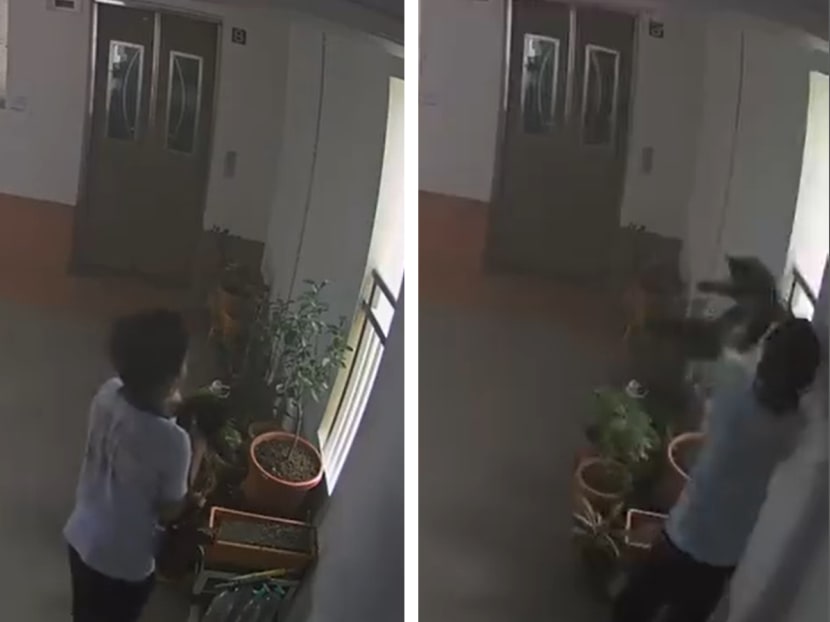Boy who threw cat off HDB block issued stern warning after completing diversionary programme: AVS
SINGAPORE — A 10-year-old boy who threw a community cat off a Housing and Development Board (HDB) block last December has been issued a stern warning after completing a diversionary programme conducted by the Animal and Veterinary Service (AVS).

Screenshots from a video on Facebook, in which a boy allegedly threw a cat off a public housing block.
SINGAPORE — A 10-year-old boy who threw a community cat off a Housing and Development Board (HDB) block last December has been issued a stern warning after completing a diversionary programme conducted by the Animal and Veterinary Service (AVS).
In a statement to the media on Friday (July 28), AVS’ group director Jessica Kwok said that the boy now better understands why his actions were wrong, and wanted to “convey his remorse and apology” to the cat’s caregivers. He also said he would not do it again.
The boy was assessed by a psychiatrist from the Institute of Mental Health, who found that he did not have sufficient maturity to understand the nature and consequences of his actions, added Ms Kwok.
The case first came to light on Dec 15, 2022 when the boy was caught on a closed-circuit television camera throwing the male cat, named Panther, off an HDB block.
Footage of the incident was then posted on Facebook, showing the boy following the black feline out of a lift, before picking the cat up and throwing it over a ledge. A loud crash can be heard seconds later.
The Facebook post said the cat was thrown off the 22nd floor of Block 186 Boon Lay Avenue. It died of its injuries.
Cat Welfare Society had helped the cat’s caregivers to file a police report. The caregivers previously told CNA that Panther had been cared for in the community for more than 15 years.
On Friday, Ms Kwok said in her statement that the boy was placed on a diversionary programme after AVS — a cluster of the National Parks Board — consulted the Attorney-General’s Chambers. The boy’s age and his psychiatric assessment were also taken into account.
The boy completed the programme in June.
Ms Kwok added: “A diversionary programme was assessed to be the most appropriate course of action as the programme centres on rehabilitation, by getting the offender to understand animal welfare, how to care for animals, living with animals in the community, and why his actions were wrong."
Through the programme, he learned about animal welfare, laws protecting animal health and welfare in Singapore, the needs and behaviour of cats, living with cats in the community, and responsible pet ownership. This was “conducted in an age-appropriate manner”, Ms Kwok noted.
The boy also underwent practical sessions at a cat shelter where he was required to properly care for cats such as feeding, handling and grooming them.
His father accompanied him throughout the programme.
“AVS assessed that the boy had completed the programme satisfactorily and is now able to understand better why his actions were wrong. The boy also regretted his actions,” said Ms Kwok.
“He wanted to convey his remorse and apology to the cat's caregivers, and said that he would not do it again. Upon the boy's completion of the programme, AVS issued a stern warning to him, and will continue to work with his school to monitor his progress.”
AVS does not condone the mistreatment of pets and community animals, and will take appropriate enforcement action against those who do not provide adequate care for their pet or commit animal cruelty, Ms Kwok added.
First-time offenders caught abusing an animal can be charged in court under the Animal and Birds Act and those convicted can be jailed for up to 18 months, fined up to S$15,000, or both.
Meanwhile, first-time offenders who fail in their duty of care to their pets can be fined up to $10,000, jailed for up to 12 months, or both.
Offenders can also be banned from owning an animal for up to 12 months. This is on top of any jail term or fine to which the offender is sentenced.
Members of the public can report suspected cases of animal cruelty to AVS via its website or Animal Response Centre at 1800-476-1600.
NO OTHER REPORTS RECEIVED
During a briefing with reporters, Ms Kwok addressed questions on allegations that the boy was involved in other similar cases in the same neighbourhood.
“For this particular boy, we did not receive any other reports of him being involved in other cases,” she said.
“If we have received any feedback, we would definitely have investigated it but we did not receive any.”
AVS has also kept in touch with the boy’s family and school to monitor his progress and ensure things are all right, Ms Kwok added.
She further noted that AVS identified and spoke to him and his mother “within hours” of receiving a report.
It then took about four months for AVS to put forth its findings and recommendations to AGC, which concurred with them that the diversionary programme was the best course of action.
“We wanted to let the boy complete the programme, and then we wanted to time (the programme) with the June school holidays so that it minimises any disruption to the schoolwork. All those were taken into consideration,” Ms Kwok said.
“So now that he’s completed the diversionary programme satisfactorily, we’ve (given a stern warning). We can close the case.
"This is why we then have arranged for this briefing, because we also understand that there are a lot of people who are very concerned about this case.”
As for whether a diversionary programme would be AVS’ future stance on children who are found to have abused animals, Ms Kwok said that AVS has to look at various factors in totality, and that not all cases will go down that route.
AVS decided that the diversionary programme was most appropriate after working with the IMH psychiatrist to better understand the boy’s level of maturity. It also worked with the boy’s school and family, she added.
Separately, Ms Kwok gave updates on two similar cases — a teenager who was caught humping a cat along a HDB block corridor in April, and several pet cats found caged and abandoned in a Jalan Minyak rental flat in June.
The teenager's case is being investigated by the police, while investigations are ongoing on the latter case.
Ms Kwok stressed that their investigators can only rely on direct eyewitnesses, CCTV footage and veterinary reports, given that the victims are voiceless.
Of the 1,250 animal cruelty cases a year that AVS investigates, about 5 per cent are substantiated with evidence to show an offence has taken place, she added.
Enforcement action has been taken in these cases, ranging from issuing warning letters to composition fines. Offenders can also be charged in court in cases involving a large number of animals, or where animal welfare was severely compromised. CNA
For more reports like this, visit cna.asia.











